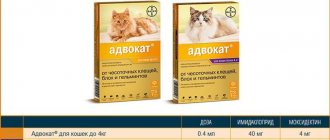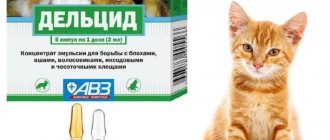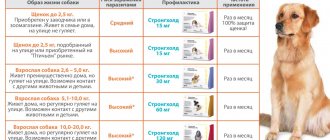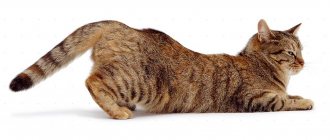Almost every veterinary specialist knows that an animal’s eyes are a “mirror” by which a specialist visually determines whether a cat is sick or not. Today in medicine, many human diseases are diagnosed by the eyes (iridology). Eye diseases in our cats are quite common today. If you do not take the necessary treatment measures in a timely manner, sometimes your pet’s disease can result in loss of vision. Before talking about eye diseases, cat owners should have an idea of what the eye is. A cat's eye is an organ specially adapted for the animal to perceive light waves. With the help of vision, your cat navigates the world around it, perceives the intensity of light, color, shape of objects, distance to them, as well as the movement of objects in space.
Domestic cats are more gentle creatures than their wild relatives. Of course, street cats' eyes fester just as often - this is due to their lifestyle. But when pus appears in the eyes of a pet furbaby, a caring owner will not ignore this alarm signal in any case. Each owner of his pet will strive to figure out why the cat has pus in the eyes, since this is a symptom that the cat is sick with something and will take the necessary measures to eliminate this situation.
Eye drops for cats: indications
The prescriptions for the use of various eye drops in cats are similar, so it is possible to generalize the recommendations for their use.
Anandin for cats
The medicine is prescribed in this form in the following cases:
- infected injuries of the organs of vision (in complex treatment);
- preparing a cat for ophthalmic surgery;
- prevention of complications after eye surgery;
- conjunctivitis of various natures and forms;
- keratitis;
- blepharitis;
- inflammatory processes in the nasolacrimal ducts.
The manifestations of many eye pathologies in cats are similar, which is why trying to self-medicate is quite dangerous. In case of severe lesions, drops are used only in complex therapy in parallel with antibiotic injections.
Infectious conjunctivitis
Statistically the leading variant of inflammation of the conjunctiva. Depending on the pathogen, it is divided into subgroups: viral, bacterial, fungal. Moreover, the incidence in children is distributed among these subgroups with approximately equal frequency, while in adults predominantly viral forms are found (over 80%). In the overall structure of morbidity, the proportion of fungal conjunctivitis (ophthalmomycosis) is increasing, which is explained, first of all, by the catastrophically irresponsible and uncontrolled use of antibiotics by the population (when the bacterial flora is suppressed, fungal cultures, including pathogenic ones, are activated).
Drugs for the treatment of viral conjunctivitis
With viral conjunctivitis (it can be caused by influenza viruses, herpes, etc.; in total there are about 40 species dangerous to humans), the main therapeutic goal is to stimulate and intensify the immune response. For this purpose the following are appointed:
- eye drops based on human interferon (Ophthalmoferon, Interferon, etc.);
- drugs that stimulate the production of endogenous, own interferon (Poludan, Tsitovir, Cycloferon);
- eye ointments (Bonafton, Acyclovir, Florenal, etc.);
- according to indications - vasoconstrictor and/or moisturizing drugs (“artificial tears”), similar to Vizin, Oksial, etc.
Drops and ointments for bacterial (purulent) form
For bacterial conjunctivitis, antibiotics are prescribed:
- drops (Albucid, Levomitin, Tsipromed, etc.);
- eye ointments (tetracycline, erythromycin, gentamicin, ofloxacin);
- tablet drugs (Doxycycline, Sumamed, Vilprafen, etc.; for chlamydia, Levofloxacin, Lomefloxacin).
Only a specialist can prescribe medications (and their dosage, frequency and duration of use) and evaluate the effectiveness of their use! By contacting our ophthalmology center, you can be sure of an individual approach and high results in the treatment of eye diseases in children and adults.
Treatment of fungal infections (mycoses)
For fungal conjunctivitis (ophthalmomycosis), treatment, as a rule, lasts much longer than for other infectious conjunctivitis, and includes specific antimycotic agents, and antifungal eye drops are practically not produced on an industrial scale in the world - they are prepared extemporaneously (as needed): Fluconazole , Amphotericin et al.
Some cases require additional intake of tablet forms of the antimycotic, as well as the simultaneous use of anti-inflammatory, antihistamine (antiallergic) and antibacterial drops and ointments.
Fig. 3 Eye drops are placed behind the eyelid at night and provide long-lasting effects
Directions for use: how to instill eye drops into a cat
For an animal, the number of instillations per day depends on the prescribed drug, general condition and the instructions of the veterinarian.
The method by which the composition is administered is the same for all types of eye drops. Before instillation, the eyes are washed using a furatsilin solution, a special lotion or saline solution.
A drop of the composition is instilled into each eye of the cat under the lower eyelid.
Ciprovet for cats
A large dosage is not required, as the product will flow out. If the animal responds calmly to treatment, then the bottle can be presented from any side. For cautious pets who are afraid of manipulation, the drops are brought to the eye from the back of the head so that they cannot see anything and become nervous.
When treating an aggressive animal, it is advisable to perform procedures with an assistant. The cat is wrapped in a thick blanket or tucked into the sleeve of a jacket.
While one person is holding the animal, the second is burying it. If the cat categorically does not allow eye drops, you should consult a veterinarian, since there is a high probability that the pet simply cannot tolerate the prescribed drug.
Be sure to read:
Can cats be given analgin and in what dosage, analogues of the drug
Prevention
In order to keep your cat’s eyes healthy, it is necessary to follow preventive measures:
- First of all, while walking, you need to avoid injury. If your pet has received minor wounds, it is necessary to treat them as quickly as possible.
- A small kitten needs daily rinsing; for this you can use plain boiled water or a herbal decoction.
- Timely vaccinations will help keep your cat healthy and protect him from infectious diseases and colds.
- Regular use of anthelmintic drugs will help avoid infection with parasites and prevent the occurrence of an allergic reaction to the products of their excretion.
- Scratching wounds located near the eyelids should not be allowed, as this can lead to suppuration of the eye. It is better to trim the hair growing near the organ of vision a little, especially for long-haired breeds.
In other words, this is caring care from the owner, timely preventive vaccinations, and regular medical examinations. If you promptly treat small wounds received while walking, you can avoid health problems, the symptoms of which may be purulent discharge from the eyes.
What eye diseases are common in cats?
The main eye pathologies in cats are:
- Conjunctivitis - when the disease occurs, inflammation of the mucous membrane of the eyelids occurs. The reasons for the development of the disease are varied - from dirt getting into the eye to infection.
- Keratitis is an inflammation of the cornea in cats that usually also affects the eyelids.
- Blepharitis is an inflammation of the eyelids, which may be accompanied by the formation of ulcers.
- Cataracts are similar to this disease in humans and are treated with surgery.
Other pathologies of the visual organs in cats are rarely observed. Injuries to the eyeball more often occur in pets that have free access to the street.
Medicines for chronic conjunctivitis
Chronic conjunctivitis, as a rule, means irritation and inflammation of the conjunctiva caused by prolonged exposure to harmful physical or chemical factors, or active foci of chronic infection in other organs.
Against the background of long-existing inflammation, the composition of the tear film and the amount of tears changes, and dry eye syndrome (DES) develops, which over time can develop into a severe form - corneal-conjunctival xerosis. In this case, epithelial defects occur (recurrent erosion), and a corneal ulcer may develop (a serious disease that threatens complete blindness).
Therefore, it is important not only to treat the cause of conjunctivitis, but also to use tear substitutes.[1]
Fig. 4 Tear substitutes (moisturizing drops) used for chronic conjunctivitis
“Cationorm” is a unique cationic emulsion that is suitable for people with glaucoma, blepharitis, allergic conjunctivitis and people using hormone replacement therapy (menopausal hormones, oral contraceptives). The drug restores all three layers of tears and prevents itching and redness of the eyes. Cationorm helps with severe pain and dryness in the eyes that appears in the morning, and quickly relieves discomfort. Drops can be applied directly to lenses. Drops should be used 1-2 drops into the eye sac 1-4 times a day.[2]
"Ocutiarz" - eye drops based on hyaluronic acid (a natural component of human tears) with an ultra-high molecular weight help to quickly relieve dryness and eliminate pain in the eyes that occurs occasionally after prolonged visual work (computer syndrome in office employees, motorists/motorcyclists, frequent fliers , travelers, students). In addition, the drops are suitable for people after ophthalmic surgery and people who have recently worn contact lenses. They do not contain preservatives and can be in direct contact with lenses. Directions for use: 1-4 times a day, 1 drop.[3]
“Oftagel” is an eye gel with carbomer in maximum concentration that moisturizes the ocular surface for a long time, eliminates pain and lacrimation of the eyes, and does not require frequent instillation; it can be used once a day as a means of additional eye hydration. Suitable for people who do not have the opportunity or desire to use drops during the day. Use 1 drop of the drug 1 – 4 times a day, depending on the severity of symptoms.[4]
In conclusion, the following points need to be emphasized:
Modern drugs used in ophthalmology, as a rule, have a wide spectrum and combined nature of action, so the same medicine can be prescribed for different types and forms of conjunctivitis. On the other hand, each variant of the inflammatory process requires a special approach - for example, a herpes viral infection is treated slightly differently than a “simple” adenoviral infection.
Further, there are very dangerous, but statistically rarer, or not typical for our latitudes forms of conjunctivitis - parasitic, epidemic Koch-Wicks, etiologically unclear, mixed (involving the cornea, eyelids, etc.) - therapy for which is beyond the scope of this article.
Finally, many of the drugs described above have absolute or relative contraindications, i.e. should be excluded or prescribed in sparing dosages (or under special medicinal cover) in the treatment of conjunctivitis in such categories of patients as children, pregnant or lactating women, people with weak immunity, patients with severe somatic pathology, etc. Considering the huge number of such clinical, therapeutic , pharmacological nuances, any attempts at self-medication, incl. "folk" means. Conjunctivitis of any genesis (origin) is not as harmless as it seems to many; in some cases, it poses a direct danger to vision, which is why timely seeking ophthalmological help is so important.
Material prepared by: Sagonenko Dmitry Alekseevich
Ophthalmologist, site consultant
List of sources used
- Kovalevskaya M.A., Maychuk D.Yu., Brzhesky V.V. Red eye syndrome. Practical guide for ophthalmologists. Moscow, 2010
- Brzhesky V.V., Algorithm for choosing tear replacement therapy in patients in outpatient practice, Clinical Ophthalmology 2022, No. 1
- Instructions for use of Ocutiarz® ophthalmic moisturizing solution
- Maychuk Yu. F., Yani E. V., Maychuk D. Yu. Artificial tear preparation Oftagel in the treatment of dry eye syndrome after epidemic keratoconjunctivitis / Breast Cancer “Clinical Ophthalmology”, No. 4 of November 12, 2001, p. 172.
- Back
- Forward
Add a comment
Symptoms of a pet's disease
When a pet gets sick, accompanying symptoms immediately appear. If the owner notices one or more of the following signs of disease in the kitten, he needs to urgently contact a veterinarian.
- The pet has become aggressive and angry, very often rubbing its eyes with its paw:
- The kitten refuses to eat and sleeps poorly;
- In the light, the pet closes its eyes and tries to stay in a dark corner;
- Increased body temperature;
- The eyes water, become red, and purulent formations flow out of them;
- The fur takes on a brownish tint after about a century.
Treatment regimens for retinal angiopathy
Drug therapy in the case of angiopathy and its vascular complications should be comprehensive. If necessary, treatment can be continued in courses. Before prescribing it, an ophthalmologist develops a specific, most effective regimen for using drugs. As a rule, these are the following appointments:
- Drug therapy aimed at activating blood circulation in the vessels of the eyes is necessary. This is a course treatment with Emoxipin, Vazonit, Mildronate, Arbiflex, Solcoseryl, Trenatal. They help activate local microcirculation processes. Another property of these drugs is improving the plasticity of red blood cells. This allows them to move faster through the small vessels of the eyes.
- Pentoxifylline and Curantil help prevent possible thrombus formation. Xanthiol nicotinate and nicotinic acid improve blood rheology.
- To reduce vascular permeability, ginkgo biloba and calcium dobesilate are prescribed.
- Actovegin injections are designed to provide better nutrition to the eye tissues. To improve metabolic processes in eye tissues, ATP and cocarboxylase are used.
- It is mandatory to take vitamin complexes to maintain eye health - Lutein-intensive, Anthocyan Forte. It is important to take ascorbic acid, which accelerates microcirculation processes in blood vessels and maintains visual acuity.
- For diabetic retinopathy, it is necessary to adhere to a special diet that can neutralize diabetes mellitus and improve blood flow in the retinal vessels. It is worth remembering that prohibited foods include any food rich in fast carbohydrates (baked sweets, sweet soda, etc.). The same applies to excessively high-calorie foods. Limiting salt is also important, because it helps normalize metabolism and improve recovery processes.
- Vigorous physical exercise, included in the daily routine to give energy to the muscular system, also improves the condition of the eye vessels.
- When treating angiopathy caused by hypertension, it is mandatory to lower blood pressure levels through medications and specially designed dietary adjustments. To do this, you should contact a cardiologist and nutritionist.
- It would not be superfluous to prescribe physiotherapeutic procedures. In the case of angiopathy, magnetic therapy courses and acupuncture can show good results.
- Another physiotherapeutic method is “Sidorenko Glasses”. This device combines the effects of pneumomassage, infrasound, phonophoresis, and color therapy. The powerful effect on the retina of such a complex makes it possible to achieve good results in a short time.
- Treatment also helps with massage courses on the cervical spine.











